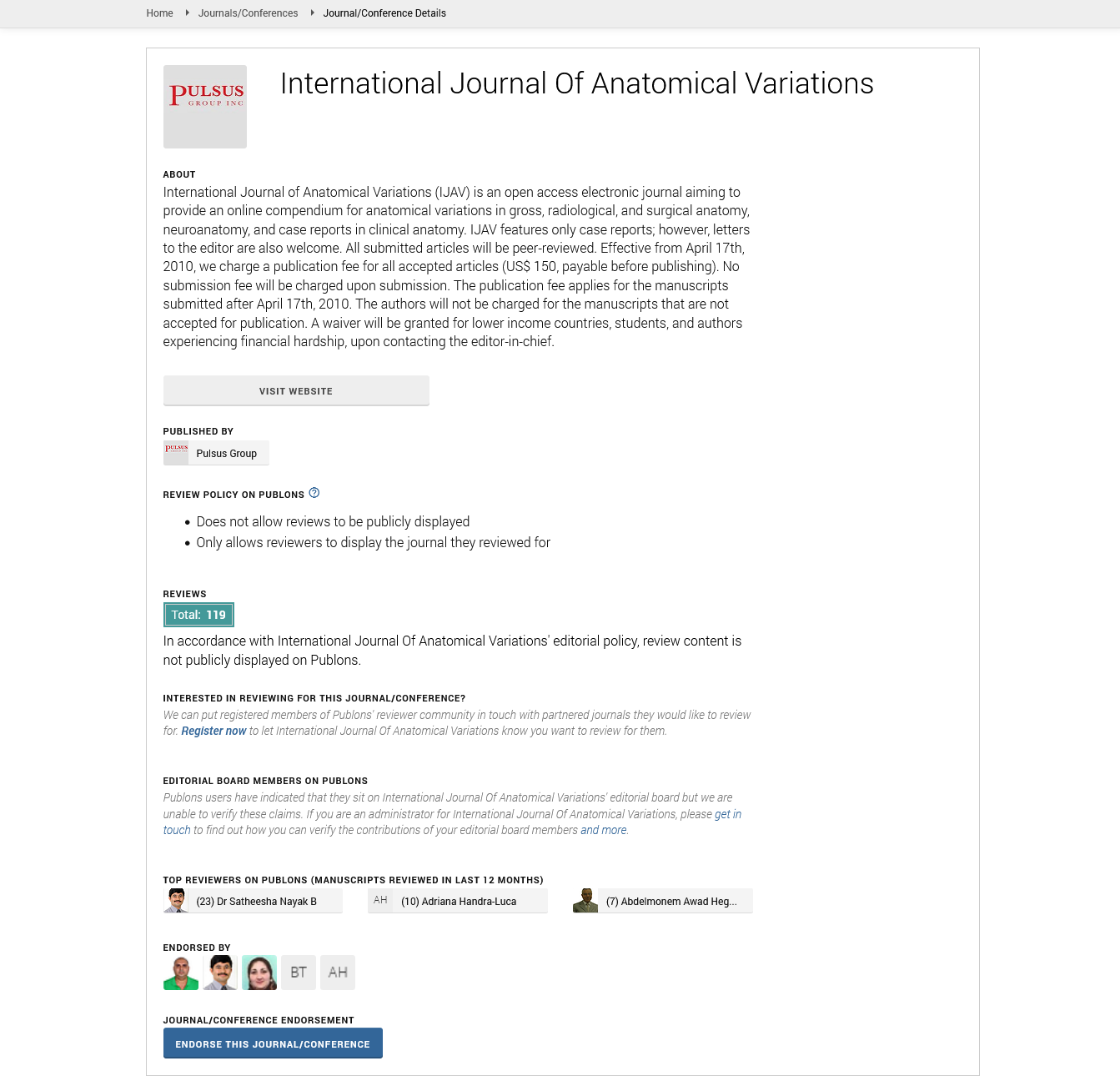Renal Artery Variations Clinical Significance and Implications
Received: 01-Oct-2024, Manuscript No. ijav-24-7324; Editor assigned: 04-Oct-2024, Pre QC No. ijav-24-7324 (PQ); Reviewed: 14-Oct-2024 QC No. ijav-24-7324; Revised: 21-Oct-2024, Manuscript No. ijav-24-7324 (R); Published: 31-Oct-2024, DOI: 10.37532/1308-4038.17(10).445
Citation: Tremblay A. Renal Artery Variations Clinical Significance and Implications. Int J Anat Var. 2024;17(10): 675-676.
This open-access article is distributed under the terms of the Creative Commons Attribution Non-Commercial License (CC BY-NC) (http://creativecommons.org/licenses/by-nc/4.0/), which permits reuse, distribution and reproduction of the article, provided that the original work is properly cited and the reuse is restricted to noncommercial purposes. For commercial reuse, contact reprints@pulsus.com
Abstract
Renal artery variations are an essential area of study in vascular anatomy due to their significant clinical implications in renal surgeries, radiological assessments, and kidney transplantation. Understanding these variations helps clinicians avoid complications and improve surgical outcomes. This article reviews the types of renal artery variations, their embryological origins, diagnostic methods, and clinical relevance, particularly in surgical and interventional contexts.
Keywords
Renal artery variations, Anatomical anomalies, Kidney surgery, Imaging techniques, Vascular complications
INTRODUCTION
The renal arteries are vital blood vessels that supply oxygenated blood to the kidneys, which are essential organs responsible for filtering waste, balancing electrolytes, and regulating blood pressure. Each kidney receives blood from a single renal artery, which branches off from the abdominal aorta, typically just below the level of the superior mesenteric artery. These arteries enter the kidneys at the hilum, where they further branch into smaller arteries, ultimately supplying blood to the renal cortex, medulla, and glomeruli. The renal arteries are crucial not only for kidney function but also for maintaining overall circulatory and metabolic homeostasis [1]. Understanding the anatomy and variations of the renal arteries is important in diagnosing and managing conditions such as renal artery stenosis, hypertension, and kidney transplant surgeries.
ANATOMY OF THE RENAL ARTERY
The renal arteries are paired blood vessels that originate from the lateral aspect of the abdominal aorta, typically at the level of the L1-L2 vertebrae, just below the superior mesenteric artery. Each renal artery supplies a kidney and enters the organ at the hilum, where it divides into several branches. The primary renal artery often gives off smaller branches as it approaches the kidney, including the inferior and superior polar arteries, which supply the upper and lower poles of the kidney. Upon entering the renal hilum, the renal artery bifurcates into the segmental arteries, which further divide into interlobar arteries that run between the renal pyramids [2]. These interlobar arteries give rise to arcuate arteries, which arch along the border of the renal cortex and medulla. The arcuate arteries then branch into interlobular arteries, supplying the renal cortex and glomeruli. The renal artery also gives rise to smaller vessels, such as the vasa recta, which supply the renal medulla. The anatomy of the renal artery is crucial for ensuring adequate blood flow to the kidneys and maintaining normal renal function, with any blockages or abnormalities potentially leading to conditions like renal artery stenosis or ischemic kidney disease.
COMMON VARIATIONS IN THE RENAL ARTERY
Common variations in the renal artery can include differences in its origin, branching patterns, and number of arteries supplying the kidneys. One of the most notable variations is the presence of accessory renal arteries, where an additional artery, or sometimes multiple arteries, arise from the abdominal aorta or other nearby vessels, such as the iliac arteries, to supply the kidneys. These accessory arteries typically enter the kidney at the hilum alongside the main renal artery [3]. In many cases, accessory renal arteries are asymptomatic and discovered incidentally during imaging studies, but they may complicate surgical procedures, such as nephrectomy or renal transplantation, where their presence must be carefully considered to prevent inadvertent damage.
Another common variation is bifurcation of the renal artery before it enters the kidney. Instead of the typical single renal artery dividing into segmental arteries at the hilum, the main renal artery may divide earlier into two or more branches, which directly supply the kidney. Additionally, the origin of the renal artery can vary; while the renal arteries usually arise from the abdominal aorta, they may occasionally originate from other vessels, such as the common iliac artery or, in rare cases, the right or left renal artery can have a more atypical position or course, such as crossing over the midline. These variations can be clinically significant, especially in the context of renal artery stenosis, surgical interventions, or imaging, as they may require specialized techniques to avoid inadvertent injury or to ensure proper vascular access. Understanding these anatomical variations is essential for accurate diagnosis and treatment planning in both nephrology and urology [4].
EMBRYOLOGICAL ORIGINS OF RENAL ARTERY VARIATIONS
The embryological origins of renal artery variation are primarily linked to the complex development of the renal vasculature during fetal growth. The kidneys initially receive blood supply from vessels that arise from the aorta at various levels as the renal arteries develop from a series of branches. During early embryogenesis, the kidneys are supplied by a series of arteries that progressively form and then regress. The definitive renal artery typically arises from the abdominal aorta at the level of the L1-L2 vertebrae. However, variations occur due to the persistence of additional or atypical arterial branches that form during the developmental stages. As the kidneys ascend from their initial position in the pelvis to their final position in the abdomen, their blood supply may shift, resulting in accessory renal arteries or aberrant origin points. These variations can be influenced by factors like the timing of vascular development and the pattern of vascular remodeling. Such anatomical diversity is significant clinically, particularly in surgical interventions like renal transplant or nephrectomy, where understanding these variations is crucial for avoiding complications [5].
CLINICAL IMPLICATIONS OF RENAL ARTERY VARIATIONS
Renal artery variations have important clinical implications, particularly in surgical procedures and diagnostic imaging. The presence of accessory or aberrant renal arteries can complicate renal surgeries, such as nephrectomy or kidney transplantation, where an understanding of the exact vascular anatomy is crucial to prevent accidental injury to vital vessels. In kidney transplantation, for instance, an accessory renal artery may require additional anastomoses to ensure adequate blood supply to the transplanted organ [6]. Similarly, renal artery variations can pose challenges in interventional radiology, where procedures like angioplasty or stenting may be complicated by unusual vascular anatomy. On the diagnostic side, these variations can lead to misinterpretation of imaging studies, such as CT angiography or ultrasound, which could delay the correct diagnosis or alter the approach to treatment [7]. Moreover, renal artery variations may be associated with other renal anomalies or conditions, such as hypertension or chronic kidney disease, making it important for clinicians to be aware of these anatomical differences when assessing patients. Understanding and identifying these variations through preoperative imaging or angiography can greatly improve surgical planning, reduce the risk of complications, and ensure better patient outcomes [8].
CONCLUSION
In conclusion, renal artery variations are of significant clinical importance, as they can affect the management of various renal conditions and complicate surgical and interventional procedures. Knowledge of these anatomical differences is crucial for minimizing risks during surgeries such as nephrectomy or kidney transplantation, where unrecognized variations can lead to vessel injury or compromised blood flow. Furthermore, understanding renal artery anatomy is essential for accurate diagnosis and effective treatment planning in interventional radiology and imaging. As these variations may also be linked to other renal pathologies, their recognition can enhance clinical decision-making, improve patient outcomes, and reduce procedural complications. Therefore, thorough preoperative evaluation using imaging techniques, alongside a comprehensive understanding of renal vasculature, is vital for optimizing patient care and ensuring safe, effective interventions.
REFERENCES
- Anri S, Masayoshi O, Shigeru H. Glomerular Neovascularization in Nondiabetic Renal Allograft Is Associated with Calcineurin Inhibitor Toxicity. Nephron. 2020; 144 Suppl 1:37-42.
- Mamikonyan VR, Pivin EA, Krakhmaleva DA. Mechanisms of corneal neovascularization and modern options for its suppression. Vestn Oftalmo. 2016; 132(4):81-87.
- Gaigalaite V, Dementaviciene J, Vilimas A, Kalibatiene D. Association between the posterior part of the circle of Willis and vertebral artery hypoplasia. PLoS ONE. 2019; 14(9): e0213-226.
- Mujagic S, Kozic D, Huseinagic H, Smajlovic D. Symmetry, asymmetry and hypoplasia of intracranial internal carotid artery on magnetic resonance angiography. Acta Med Acad. 2016; 45:1- 9.
- Rusu MC, Vrapclu AD, Lazar M. A rare variant of accessory cerebral artery. Surg Radiol Anat. 2023; 45(5):523-526.
- Krause DA, Youdas JW. Bilateral presence of a variant subscapularis muscle. Int J Anat Var. 2017; 10(4):79-80.
- Mann MR, Plutecki D, Janda P, Pękala J, Malinowski K, et al. The subscapularis muscle‐a meta‐analysis of its variations, prevalence, and anatomy. Clin Anat. 2023; 36(3):527-541.
- Pillay M, Jacob SM. Bilateral presence of axillary arch muscle passing through the posterior cord of the brachial plexus. Int. J. Morphol., 27(4):1047-1050, 2009.
Indexed at, Google Scholar, Crossref
Indexed at, Google Scholar, Crossref
Indexed at, Google Scholar, Crossref
Indexed at, Google Scholar, Crossref
Indexed at, Google Scholar, Crossref
Indexed at, Google Scholar, Crossref






